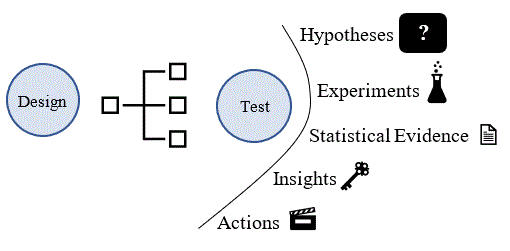Analytical Methods
Powerful Tools
Analytics are used to organize data, extract information, visualize (make it accessible) results, and communicate findings.
Introduction to Analytics
New to analytics or need a quick refresher? Check out our Intro to Analytics video for a brief overview of analtyics and discussion on why firms invest in analytics. For more detailed information on analytics, read on.
Descriptive Analytics
Descriptive analytics is a collection of methods used to transform raw data into meaningful information. Analysts use descriptive methods to explore past data, measure performance, and monitor Key Performance Indicators (KPI’s) in real-time. Descriptive methods involve applying simple statistical measures to the data and often include counts, proportions, means, standard deviations, percentages, and percentiles.




Diagnostic Analytics
Diagnostic Analytics address why events or outcomes have occurred in the data. Building on the information gained by applying descriptive analytics, diagnostic methods go a step further by answering the question: Why did this happen? By using diagnostic methods, organizations can explain the information found in descriptive analytics. Standard diagnostic tools include comparing distributions across categories, investigating covariances and correlations, geographic analysis, and assessing changes across time.
Predictive Analytics

Experimental Analytics: A controlled scientific experiment is used to test and identify how factors affect behavior, a process, or an issue. Experiments are used to generate meaningful data that often reveal the true impact of a factor and allow the organization to draw meaningful conclusions.
Common Applications:
-
Digital marketing – A/B testing
-
Promotions
-
Email and website design
-
Employee retention
-
Customer retention

Statistical Modeling: Statistical modeling begins with the identification of a problem, a goal, or a hypothesis. Then a mathematical model is developed to formalize relationships among a collection of factors (variables or attributes) that influence the issue at hand. We then use data and statistical methods to quantify these relationships and assess whether statistical or economic significance is present. Based on the statistical findings, an action plan is developed to achieve the goal or overcome the problem.
Common Methods:
-
Regression
-
Logistic Regression
-
Forecasting
-
ANOVA
-
Survival Analysis
-
Time Series Analysis


Prescriptive Analytics
Prescriptive Analytics is the formulation of an action plan to prescribe a treatment for a problem or improve an outcome. These analytics use the insights and information learned from descriptive, diagnostic, and predictive methods to generate a detailed action plan. In addition to the action plan, Prescriptive Analytics describes how much the action will cost and how the organization will benefit.
